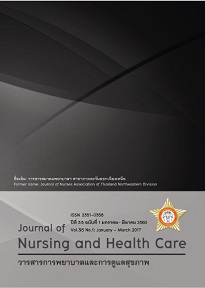ปัจจัยที่สัมพันธ์กับการเกิดปอดอักเสบที่สัมพันธ์กับการใช้เครื่องช่วยหายใจระยะแรก ของผู้ป่วยวิกฤตอายุรกรรม Factors Associated with Early-onset Ventilator-associated Pneumonia Development among Critically Ill Medical Patients
คำสำคัญ:
ปอดอักเสบที่สัมพันธ์กับการใช้เครื่องช่วยหายใจ, ปัจจัยเสี่ยง Ventilator-associated pneumonia, risk factorsบทคัดย่อ
บทคัดย่อ
การศึกษานี้เป็นการศึกษาเชิงวิเคราะห์แบบไปข้างหน้า มีวัตถุประสงค์เพื่อศึกษาอุบัติการณ์และปัจจัยที่สัมพันธ์กับการเกิดปอดอักเสบที่สัมพันธ์กับการใช้เครื่องช่วยหายใจระยะแรก โดยศึกษาในผู้ป่วยที่มีอายุ 18 ปีขึ้นไปที่ได้รับการใส่ท่อช่วยหายใจและใช้เครื่องช่วยหายใจไม่เกิน 48 ชั่วโมงโดยเลือกกลุ่มตัวอย่างแบบเฉพาะเจาะจงจำนวน88 คน ที่เข้ารับการรักษาแผนกอายุรกรรม 6 หอผู้ป่วยในโรงพยาบาลขอนแก่น ดำเนินการเก็บรวบรวมข้อมูลระหว่างเดือน ตุลาคม 2558 และเดือนมีนาคม 2559 เครื่องมือที่ใช้ในการรวบรวมข้อมูลประกอบด้วยแบบประเมินมาตรฐานGlasgow Coma Scale, APACHE II Score, CPIS Score และแบบบันทึกข้อมูลที่ผู้วิจัยสร้างขึ้นจากการศึกษาแนวคิด ทฤษฏี เอกสารต่างๆที่เกี่ยวข้องวิเคราะห์ข้อมูลโดยใช้สถิติเชิงพรรณนา และวิเคราะห์ปัจจัยที่สัมพันธ์กับการเกิดปอดอักเสบที่สัมพันธ์กับการใช้เครื่องช่วยหายใจโดยใช้ Cox proportional hazard regressions
ผลการศึกษาพบว่ามีผู้ป่วยเกิดปอดอักเสบที่สัมพันธ์กับการใช้เครื่องช่วยหายใจระยะแรกจำนวน 10 คน (ร้อยละ 11.36) คิดเป็นอุบัติการณ์การเกิดปอดอักเสบที่สัมพันธ์กับการใช้เครื่องช่วยหายใจเท่ากับ 32.36 ครั้งต่อ 1,000 วันที่ใช้เครื่องช่วยหายใจ ปัจจัยเสี่ยงอิสระที่ทำให้เกิดปอดอักเสบที่สัมพันธ์กับการใช้เครื่องช่วยหายใจมี 3 ประการคือ 1) การใส่สายให้อาหารและได้รับอาหารทางสายให้อาหารแบบหมดทันทีซึ่งจะเพิ่มความเสี่ยง 8.64 เท่าเปรียบเทียบกับผู้ป่วยที่ไม่ได้รับอาหาร (HR= 8.64, 95% CI: 1.005-74.28) 2) การได้รับการใส่ท่อช่วยหายใจซ้ำมากกว่า 1 ครั้งซึ่งเพิ่มความเสี่ยง 3.65 เท่าเปรียบเทียบกับผู้ที่ไม่ได้ใส่ท่อซ้ำ (HR= 3.65, 95% CI: 1.03-12.91)และ3) การจัดระดับความสูงหัวเตียง 30 องศาน้อยกว่า 11 ชั่วโมงต่อวันจะเพิ่มความเสี่ยง 21.12 เท่าเปรียบเทียบกับผู้ที่มีระดับหัวเตียง 30 องศามากกว่า 11 ชั่วโมงต่อวัน (HR= 21.12, 95% CI: 1.02-439.38)ผลการศึกษาครั้งนี้สะท้อนว่าปัจจัยที่สัมพันธ์กับการเกิดปอดอักเสบที่สัมพันธ์กับการใช้เครื่องช่วยหายใจระยะแรก ล้วนเป็นปัจจัยที่เกี่ยวข้องกับการปฏิบัติการพยาบาล ดังนั้นพยาบาลจึงควรปรับวิธีการดูแลโดยให้อาหารทางสายยางแบบหยดช้าๆ ป้องกันไม่ให้เกิดการใส่ท่อช่วยหายใจซ้ำ และการจัดระดับหัวเตียงให้สูงในระยะเวลาที่เหมาะสม เพื่อป้องกันการเกิดปอดอักเสบที่สัมพันธ์กับการใช้เครื่องช่วยหายใจ
Abstract
This prospective cohort study aimed to investigate the incidence of early-onset ventilator-associated pneumonia (VAP) and factors associated with early-onset VAP development among critically ill medical patients. Study subjects were 88 patients, age 18 years and older, who were newly intubated and treated with mechanical ventilation for less than 48 hours. Subjects were purposively selected from 6 medical wards in Khon Kaen Hospital. Data collection for VAP risk factors was completed during October 2015 and March 2016 using standard assessment forms including Glasgow Coma Scale, APACHE II Score, CPIS Score as well as checklists developed specifically for this study from relevant literatures. Descriptive statistics were used to summarize all research variables and Cox proportional hazard regressions were used to identify VAP risk factors.
Results revealed that 10 patients (11.36%) developed VAP 4 days after ET intubation, with VAP incidence of 32.36 episodes/1000 ventilator-day (95% C.I: 4.6-18.13). VAP risk factors included retention of NG tube with bolus feeding, ET re-intubation, and lower head-of-bed (HOB) elevation. Patients receiving bolus NG feeding were 8.64 times more likely to develop VAP compared to those who did not receive feeding (HR= 8.64, 95% CI: 1.005-74.28). Patients who were re-intubated one more time had 3.65 times increased VAP risk compared to those who were not re-intubated (HR= 3.65, 95% CI: 1.03-12.91). Lastly, patients who had HOB elevation at least 30 degree for less than 11 hours per day had increased VAP risk of 21.12 times, compared to those with 30 degree HOB elevation for longer than 11 hours per day (HR= 21.12, 95% CI: 1.02-439.38). These results reflected that independent VAP risk factors among this population were all related to nursing intervention. Subsequently, nurses must identify effective interventions particularly in NG feeding, preventing ET re-intubation and positioning the head-of-bed elevation in order to prevent VAP development among critically ill medical patients.



